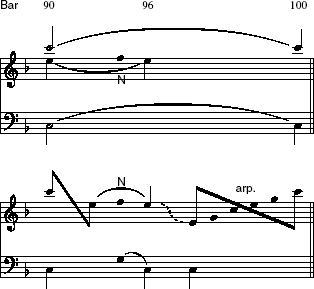3.2 The fundamental structure and the form
Although Example 10a contains no more than the notes of the fundamental structure with an indication of the bar numbers where I think they occur, it nevertheless identifies some important aspects of the form. The whole of the exposition is seen as a journey from tonic to dominant, with the C maintained as the focus of interest in the melodic lines throughout. Let's look for a moment at the end of the exposition. The structural C is established in bar 90: in the score you can see this note arrive in the violin and flute parts, after a long prolongation of the dominant chord in bars 83–9. The last section of the exposition, from bar 90 onwards, focuses in its melodic line first on E, alternating with its neighbour note F, with alternating C major and G major seventh chords; until this E climbs through the arpeggio in bars 96 to 100 to reach the C again.

Activity 12
Example 11 above shows an analysis on two levels of the bars just discussed (90–103). Compare Example 11 with the score, and listen to these bars whilst following the graphs. How do these graphs analyse the structure of this final section of the exposition?
Click to open the full score of Beethoven's Eighth Symphony, third movement [Tip: hold Ctrl and click a link to open it in a new tab. (Hide tip)] .
Answer
Discussion
I have analysed these bars as a prolongation of the tonic harmony, with C at the top, and with the intervals from C to E and back again unfolded. The alternation of C major and G major triads is therefore an ‘alto-voice’ feature at this background level – these chords are not true perfect cadences here, but a reinforcement of the C major dominant harmony established at bar 90. Example 11a shows the background as it is given in Example 10b, and Example 11b shows the middleground elaboration of this structure.
Let's return now to Example 10a, and look further at what its picture of the fundamental structure means. The graph analyses the whole of the development section as leading up, harmonically speaking, to the re-establishment of the tonic F major at bar 198. This is done through a few modulations to keys not terribly distant from F major, aiming towards the long dominant pedal from bar 176 onwards; even the D flat chords around bar 168 are part of a middleground feature in the bass which forms a neighbour note to the C dominant pedal. When the tonic harmony arrives to inaugurate the recapitulation at bar 198, the ![]() of the fundamental line is re-introduced at the top of the melody. In my graph, the whole recapitulation is then analysed as keeping the
of the fundamental line is re-introduced at the top of the melody. In my graph, the whole recapitulation is then analysed as keeping the ![]() unresolved.
unresolved.
To consider what my analysis means here, look at the end of the recapitulation section, bars 280 to 300, which are parallel to the bars in the exposition that you have just listened to. You can see that this is almost a note-for-note repeat, in fact, transposed from C major to F major. My analysis claims that, despite the very emphatic arrival of the F and the tonic harmony from bar 287 onwards, there is no sense of completion for the movement as a whole here, because there has been no prominent and decisive fall from ![]() to
to ![]() in the upper voice. So we are not surprised at bar 301 when the repeated Fs continue in the bassoons, because we are still waiting for this closure.
in the upper voice. So we are not surprised at bar 301 when the repeated Fs continue in the bassoons, because we are still waiting for this closure.
Activity 13
See if you agree with the way I hear this section (bars 280–300) by listening to it again now. This time just listen, without following the score.
Answer
Discussion
It is rather unfair to ask you whether you agree that something has not been heard in these bars! It is the sense of ‘unfinished business’, rather than restfulness, in the continuation of the music into the coda at bars 301 ff. which leads me to feel that we still need a structural descent to give the whole movement a satisfying closure.
The structural descent, when it occurs, seems very prominent to me. The first subject reappears ff at bar 323, where the C is emphasised in the violins, doubled by clarinets and bassoons. The melody then comes to rest in bar 332 on B♭, harmonised by a C major chord, where there is even a pause marked. This prominence of B♭has been a feature throughout the movement, and here it acquires great weight aurally. Straight away in bar 333, we hear the B♭leading to an A in the violins, as we would expect; this is no more than a passing foreground feature, though, and an exhilarating passage builds up from here, with the melody slowly rising from bar 341 until the tonic harmony is reached again at bar 351. I have based my analysis on two features of the harmony at this bar: first, there is no dominant chord in bar 350 (despite the C in the bass in the last beat), so this cannot be the final cadence of the movement even though it is the loudest arrival of the tonic anywhere at fff and secondly, although the violin line rises right up to a C at the end of bar 350, the tonic arpeggios at bars 351–3 give great prominence to A, the first note in the violin line. I have therefore analysed the whole of bars 333–51 as a prolongation of the descent B♭–A in the top voice. This makes the dominant chord at bar 354 (repeated in bar 358) the structural dominant for the whole movement. So the G at the top of the violin parts in these bars is the second-to-last note of the fundamental line, and the final note arrives at bars 364–5, alternately played as the top note in strings then woodwind. The fact that this F is approached by the leading note in bars 362–3 is typical of the close of a long movement, and does two things: it emphasises that the tonic is ready to be reached, because the structural descent has already happened, and it serves to spread out the notes of this descent evenly, making the whole section balanced and satisfying (the notes come in bars 323, 332, 351, 354/8 and 364).
Activity 14
Re-read my commentary above, and then listen to the movement's coda (bars 323-end) whilst following the relevant section of Example 10. Can you hear the notes of the structural descent, as I have analysed it, where they each occur?
Answer
Discussion
Although it requires very long-range listening to hear this descent spread out over more than forty bars, I hope that the selected bar numbers marked (and the CD track numbers, if you were able to see them on your player) in Example 10 helped you to follow my analysis. I think that it is this deep structure that accounts for why this final section of the movement sounds so satisfying.
Whilst this is not the only way to analyse large musical structures, there are some aspects of Beethoven's craft – such as his mastery in creating a sense of achievement and fulfilment at the conclusion of a movement – which are often noted by listeners, but which seem to escape most attempts at analysis. If you have found this section of the course at all convincing, you should feel that we have at least approached one answer to the question of how Beethoven accomplishes his artistic effect.
